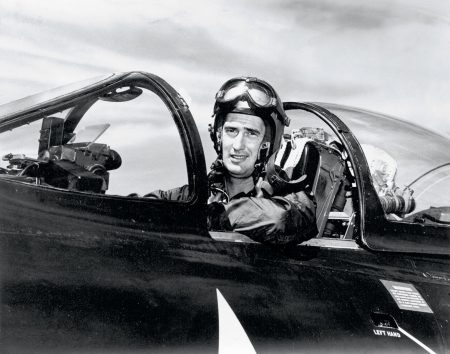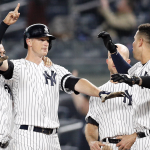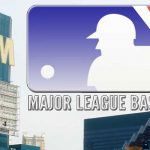Baseball, Veterans’ Day and the National Pastime
 A Veterans’ Day weekend of parades and remembrances reminded me how many major leaguers once sacrificed significant portions of their careers in defense of their country. Reminded me that the ethos of baseball exemplifies the best of Americana. And prompts the question where would America be without baseball?
A Veterans’ Day weekend of parades and remembrances reminded me how many major leaguers once sacrificed significant portions of their careers in defense of their country. Reminded me that the ethos of baseball exemplifies the best of Americana. And prompts the question where would America be without baseball?
After Pearl Harbor, ordinary players and great players wanted to protect freedom and democracy. Which is why more than 300 major leaguers joined the Army, the Navy, and the Marines. More than 3000 minor leaguers enlisted as well. And with loss of all these players, the nature of baseball changed dramatically in 1942.
The quality of existing talent and the individuals who might be added to rosters was so uneven that there was talk among baseball executives of suspending the 1942 season. But, where would America be without baseball?
That’s why President Roosevelt did not want baseball to close its doors. Roosevelt spoke forcefully that Americans at home would need the rituals that made America, America. The rituals that people turned to to forget the daily pressures of life. In short, America needed the thickness of baseball. Its legacy. History. And everything it stood for. Especially after the Japanese bombed Pearl Harbor in December 1941.
FDR offered no special dispensations for ballplayers. No soft jobs as had been the case during World War I. Players would go to war and fight like other Americans would – or at least that was the official line. And if baseball wanted to continue scheduling games, baseball would need to figure out how to best do it.
Fortunately, of the 90 percent of the players who joined the Armed Forces during World War II, not one player was killed in combat. That was because the Armed Forces used most baseball players as recruiting and morale tools rather than combat soldiers.
The First to Serve
Bob Feller, the great Cleveland Indians’ fireballer, was the first baseball player to enlist in the military, joining the Naval Reserve in 1942. Feller was quoted as saying, “America must win the war to keep baseball.” He served four years as a Gunnery Captain on the USS Alabama in the South Pacific, receiving numerous combat medals. He missed the 1942, 1943, and 1944 seasons entirely – and most of 1945.
Hank Greenberg was actually the first baseball player to register for the draft in 1940 but due to physical disabilities, he did not serve during the war. Even after the military reexamined him – at his request – they still would not draft him into the war effort.
The most well-known players were Ted Williams and Joe DiMaggio. Williams enlisted in the Navy in 1942, became an aviator and missed most of the 1943, 1944 and 1945 seasons abroad. Williams also spent 1952 and 1953 in the Korean War.
Joe DiMaggio enlisted in the Army in 1942 and also missed the 1943, 1944 and 1945 seasons. He retired in 1951 despite losing those three seasons to the war. Overall, he played 13 seasons – winning nine World Series rings and ten American League championships. A remarkable accomplishment in such a short time.
Bob Kuzava, a Yankee left-hander who saved game seven of the 1952 World Series, was affectionately called ‘Sarge’ by his teammates after he delayed the start of his major league career three years to serve in World War II. He then played 12 major league seasons, beginning in 1946 with the Cleveland Indians.
Hank Bauer was a Marine fighting in the South Pacific. He was wounded twice in action in Guam, Guadalcanal, and Okinawa. Warren Spahn fought in France, confronting Germans at the Battle of the Bulge. Stan Musial, Jackie Robinson, Enos Slaughter, Jerry Coleman, Monte Irvin, and Yogi Berra were also in the Armed Forces.
Upside Down, Inside Out
This left a motley bunch to play the games in 1942, ’43 and ’44. One-armed players like Pete Gray. Over-the-hill types like Paul Waner and Babe Herman, both of whom had seen better days, yet felt encouraged to return and man major league rosters. Other players were too old. Too fat. And even too young.
Joe Nuxhall made his major league debut a month short of his 16th birthday for the Cincinnati Reds in 1944. He pitched all of ⅔ of an inning in a game which was hopelessly lost. And then did not pitch again in the majors until 1952, hurling 12 seasons before retiring in 1966.
Regardless of the quality of play, it was still baseball. Still enjoyable. Still the diversion FDR knew it would be. And no one seemed to care if for one upside down inside out season in 1944 the St. Louis Browns, baseball’s worst team, won its only American League pennant before escaping to Baltimore in 1953. Because in those war-ravaged years MLB teams depended more and more on minor league talent to fill roster spots.
The St. Louis Cardinals then defeated the Browns in the 1944 World Series 4-2. All the games were played at Sportsman’s Park, the home stadium of both teams. This was the last time an entire World Series was played in one stadium.
But those years were not all upside down. The Yankees beat the St. Louis Cardinals 4-2 in the 1943 series, while in 1942, St. Louis beat the Yankees in five games. So quality still counted for something.
What withered was baseball’s talent acquisition process. Only nine minor leagues finished the season in 1943—down from 26 the year before. The farm system Branch Rickey established in St. Louis dwindled to only six clubs in 1943, down from 15 in 1940. Yet St. Louis still won two World Series with its array of talent. Mostly because other teams, like the Chicago White Sox, did not have even one farm team during the war years, and so had nowhere to turn to infuse new talent onto their rosters.
So…
On this Veterans’ Day, with all 30 teams so full of talented baseball players (okay, omit Miami, the New York Mets, Baltimore, San Francisco, Detroit, and even Seattle which has fallen apart since they were 14-2 the second week of April), let’s remember the years before when America depended on baseball, even without its greatest stars on the field, to remind the world what liberty and freedom were all about. What sacrifice was about. And that baseball proved once again it was, and still is, the national pastime. Because, where would America be without baseball?
For a list of players who played during World War II, see the Baseball in Wartime website.

























